DISCLOSURE: If I link to relevant products or helpful info it may be an affiliate link, meaning I may earn a small commission. As an Amazon Associate & other affiliate, I earn from qualifying purchases at no extra charge to you. The views & opinions are my own. Please see the disclaimer and privacy policy.
Last Updated on April 21, 2024
Everything you need to know about the Great Migration in Africa
The Great Migration in Africa is one of the most spectacular natural events on earth. Every year, millions of wildebeest and other hoofed animals migrate in a clockwise loop around the Serengeti-Mara ecosystem in East Africa.
This immense journey is up to 1000 km long. It takes place between Tanzania’s Serengeti National Park and Kenya’s Maasai Mara Game Reserve.
This awe-inspiring event has been a source of fascination and inspiration for generations. It draws international attention to the unique beauty of East Africa’s wildlife every year.
As one of the world’s most astounding spectacles, I think that the Great Migration in Africa is an absolute must-see for any traveler.
GUEST POST by: Deb Hendricks of Introvert with Itchy Feet
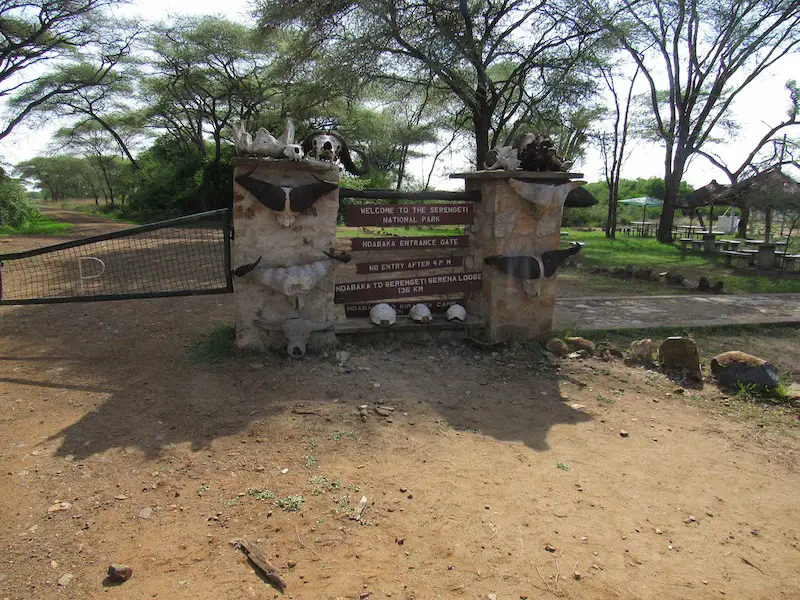
What is the Great Migration in Africa
The Great Migration in Africa is considered one of the Seven Wonders of the Natural World. It’s also often referred to as the greatest show on earth.
It’s absolutely one of the most incredible events that I’ve ever witnessed! I recommend finding a good tour company to travel with. I could never have had such an unforgettable experience if I’d decided to organize my own independent trip.
Huge herds of blue wildebeest and other grazers, over 2 million animals, travel up to 1000 km a year in a clockwise loop. They cross plains and rivers in search of fresh grazing land, covering 9 or 10 kilometers a day.
Technically the migration is ongoing throughout the year. The animals follow a circular path between the Ngorongoro Conservation Area, southeast of Serengeti National Park, north to the Maasai Mara in Kenya.
The wildebeest travel in herds of up to 1000 animals per square kilometer and graze almost continuously. In fact, this entire animal train consumes some 4500 tons of grass every single day. They follow the rains and the food supply, always on the lookout for fresh grass.
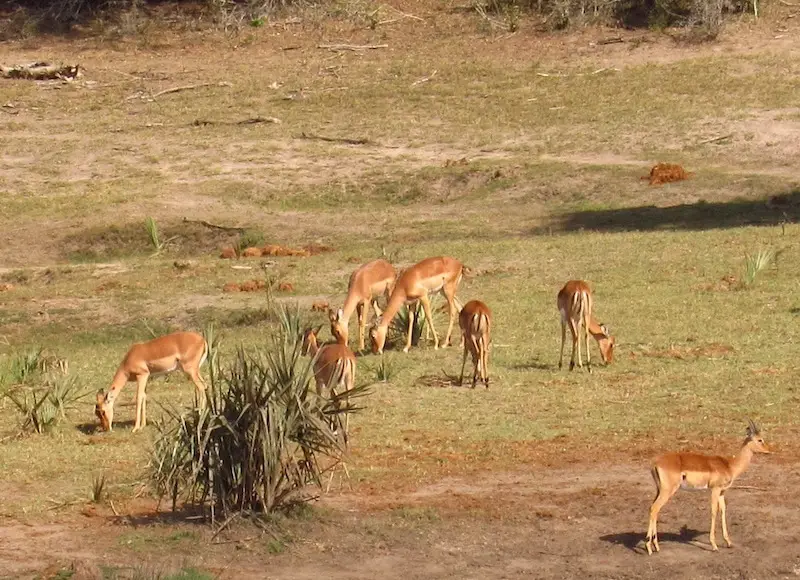
The Animals of the Great Migration in Africa
The spectacle is referred to as the Great Wildebeest Migration. Also, when you take in the site of these massive herds of animals, it can appear as if you’re seeing a sea of nothing but wildebeest.
However, there are other animals that take part.
While wildebeest, an antelope also known as gnu, outnumber the other animals in the migration, hundreds of thousands of zebras and other antelope are also a part of the show.
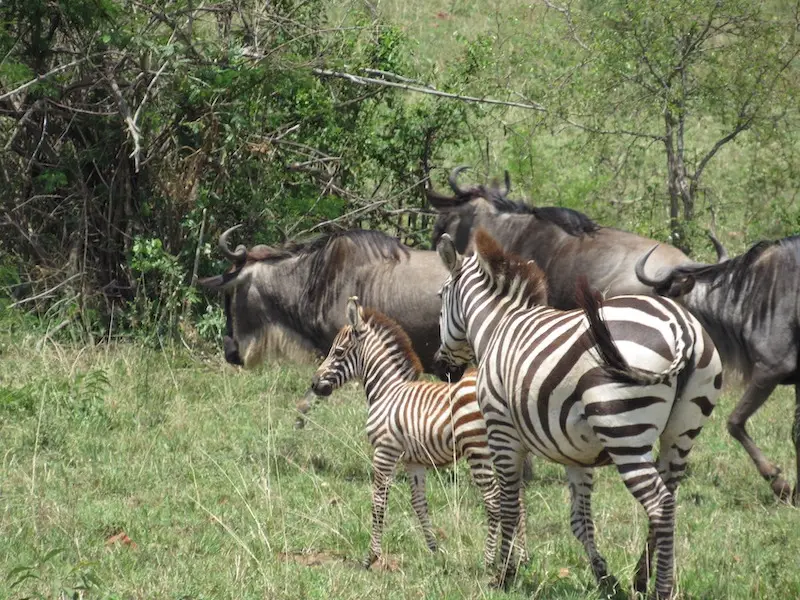
Animals Sightings during the Great Migration
- 1. Zebras. More than 300,000 zebras accompany the wildebeest on their annual journey. The zebras in this area are known as Grant’s zebras.
They’re the smallest of Africa’s zebras, the Grant’s zebra is actually the perfect travel partner for the wildebeest. They like to eat the top part of the tall grass that covers the plains.
Wildebeest, on the other hand, eat the lower portion. A match made in heaven! The two animals also eavesdrop on each other’s predator alerts. This really is a mutually beneficial partnership.
- 2. Grant’s gazelles. My guide wasn’t able to tell me if Grant’s gazelles and Grant’s zebras got their names from the same place. I did find out, though, that they’re one of two types of gazelle that typically follow this migration circuit.
- 3. Thomson’s gazelles. These tend to be the most abundant animals on the migration after the wildebeest. Their herds can number up to 300,000 on the annual loop.
- 4. Common Eland. The tallest members of the parade by far, these beautiful antelope are easy to spot if you’re lucky enough to come across one. Some 12,000 elands make this annual trip.
- 5. Impala. They might be the fastest animals on the migration. Impala can reach speeds of up to 90 km/hr!
Other animals participating in the Great Migration
The Great Migration in Africa is an important event for predators, too. Among these are lions, leopards, and cheetahs. African Wild Dogs and hyenas are also active participants.
Many migrating animals end up being taken by these predators during the migration. However, the sheer masses of animals involved in the migration prevent even more losses.
Crocodiles that live in Tanzania’s Grumeti River and Kenya’s Mara River will also take full advantage of the influx of prey. And while hippos are strict herbivores, they are very territorial. They pose an additional danger and source of drama at the river crossings.
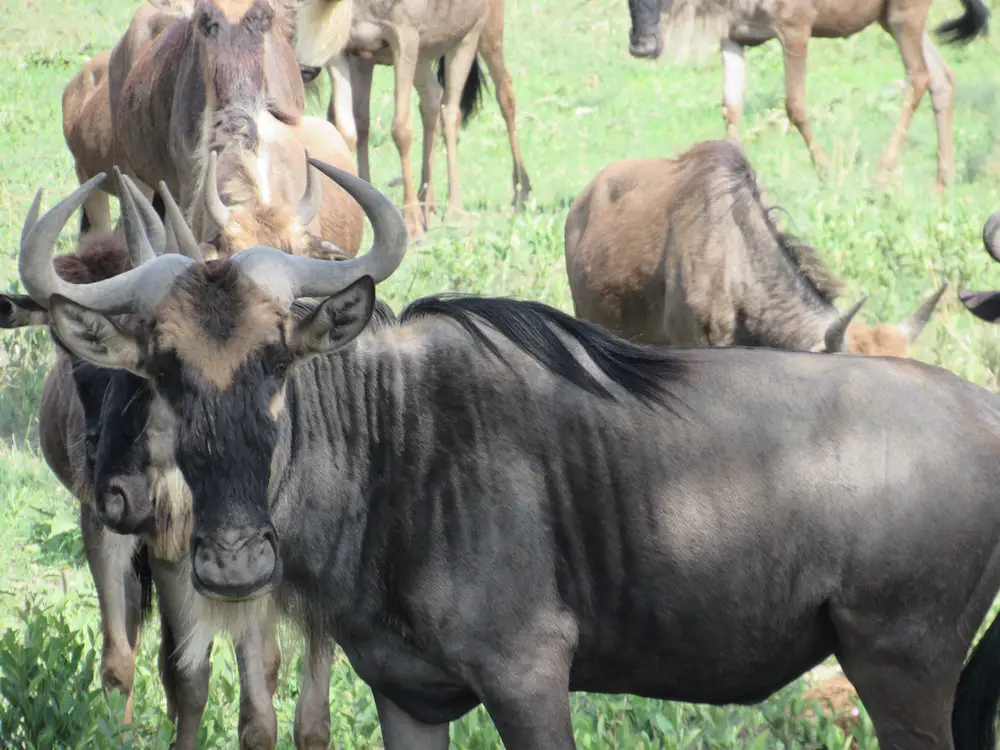
Why Does the Great Migration in Africa Happen?
The short answer is that the animals follow the rain. Rain means grass for grazing. They also need to be close to the water as they can’t survive without twice daily access to it.
The annual migration has only been a reported occurrence since the 1960s. It was around this time that, with a large portion of the lion population decimated by hunters, the wildebeest herds began to grow to the numbers we see today.
One wildebeest has to have enough food to maintain their 118-275 kg bodies. As you can imagine, a sizable herd can clear a patch of savannah grassland pretty quickly!
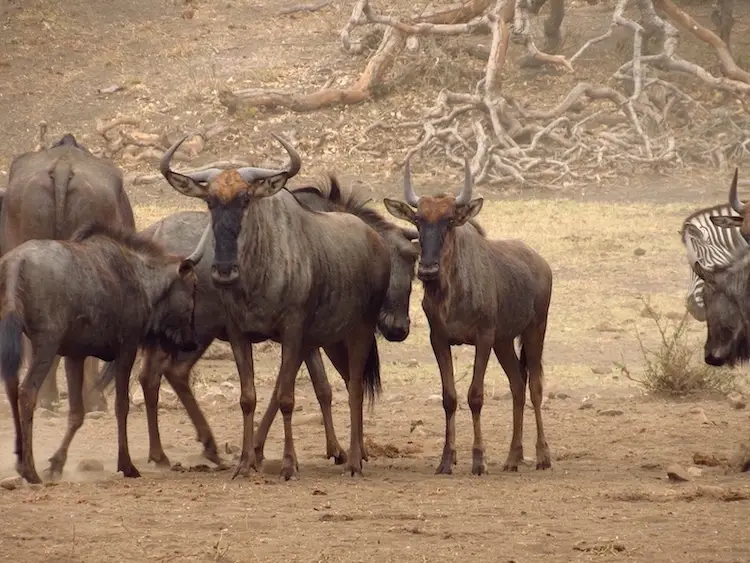
The Great Migration Path Throughout the Year
The timing of the migration can vary greatly, as can anything that depends at all on the weather. Rains might come later than they normally do, for example, or earlier. Some years they don’t come at all.
In general, though, there is a pattern. Here is a guideline to help you plan your trip to see the great migration of these African animals.
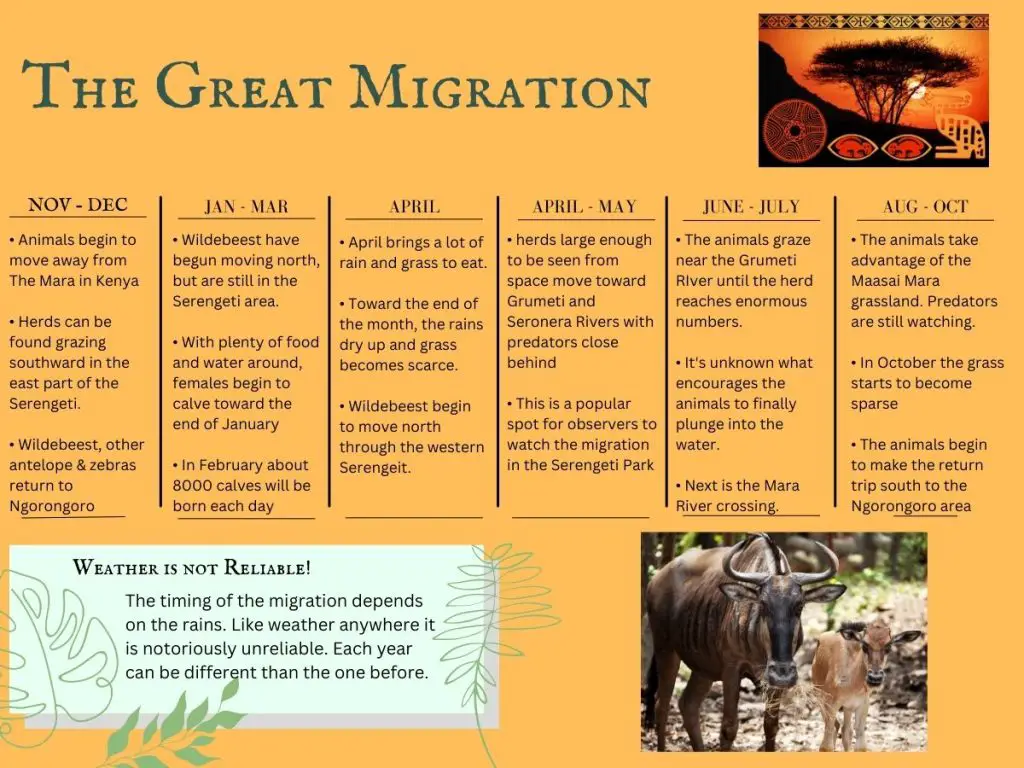
November through December
In a “typical” year, the herds of wildebeest, and other antelope, along with the zebras, are starting to wander away from the Maasai Mara area, or The Mara, toward the end of the year.
The grass is becoming sparse, and November and December see the herds moving south into the Serengeti. This is a good time to see them in the northeast area of Serengeti National Park, moving toward the south end and into the Ndutu region of the Ngorongoro Conservation area.
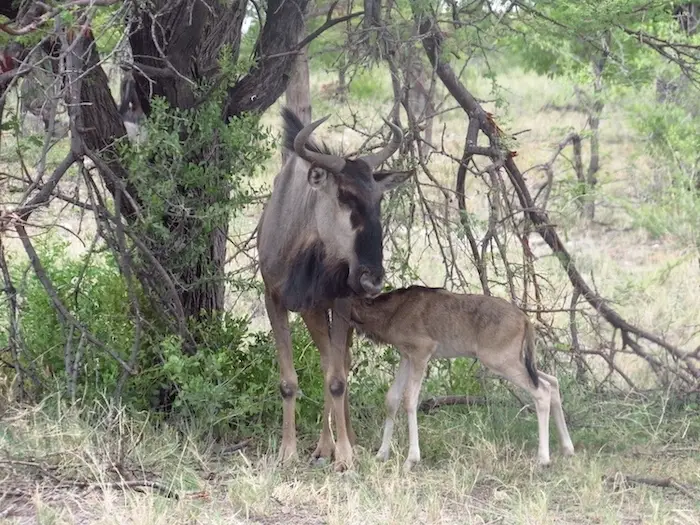
January through March
The southern end of the Serengeti and the Ngorongoro Conservation area are amazing places to be during these months. The animals are spread out and there are lots to eat. This might have been my favorite part of my migration experience.
Into January and especially in February the wildebeest begin calving. There are an incredible 8000 calves estimated born each day during the part of the migration. An estimated 400,000 wildebeest calves enter the world with each migration.
This period sees a lot of action from the predators, as well. The young calves are vulnerable, and not all 400,000 will end up making the full migration. I found this less upsetting to witness in person than I expected.
All told, roughly 250,000 of the approximately 2 million animals will not make the entire journey. They may be taken by predators, drown in a river crossing, or perish in any number of other ways
Although it can be hard to watch, this in person feels much more matter-of-fact than, for example, watching it on TV. I felt like I was watching the cycle of life. However, if you do end up finding it too upsetting to watch, you always have the option of looking away.
The herds start to slowly move north, with more and more animals joining in toward the end of March and into April. By then young calves have no trouble keeping up with the herd, as they’re able to walk minutes after birth.
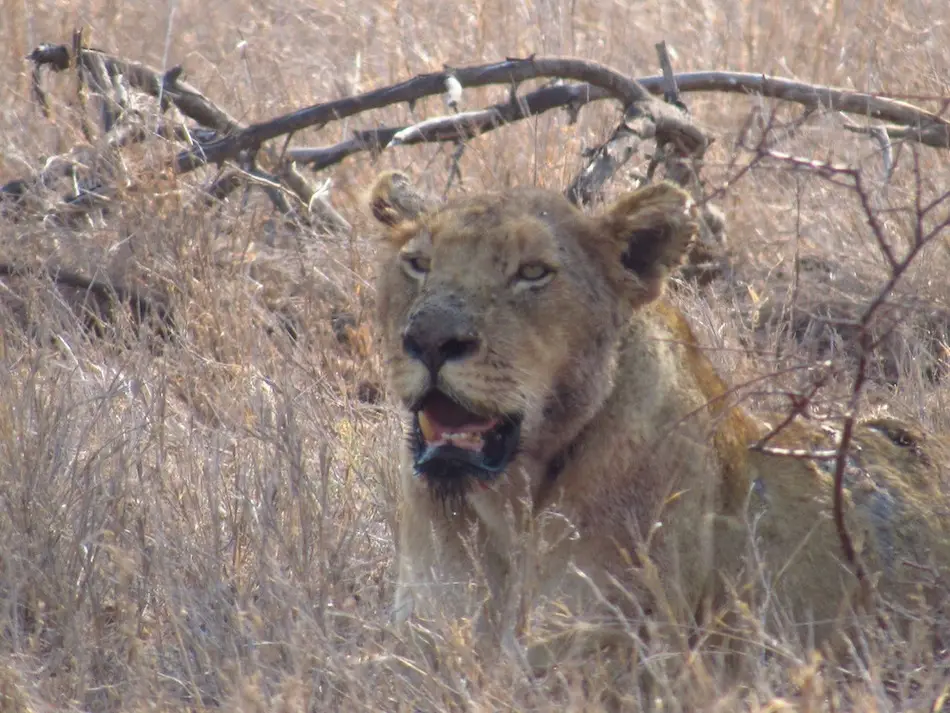
April through May
April means heavy rain, with water for everyone and plenty of grass to go around.
But as April gets old the grass in the southern Serengeti becomes scarce.
The number of animals moving north grows every day as less and less food and water is available. As the herds approach the Grumeti and Seronera Rivers, the massive columns of wildebeest, zebras, and gazelles can reach 40 kilometers in length.
That’s large enough to be seen from space! It’s overwhelming to see – and hear – so many animals together.
And lurking around and behind, in their own separate huddles, are the predators. Lions and cheetahs and hyenas, waiting for an opportunity.
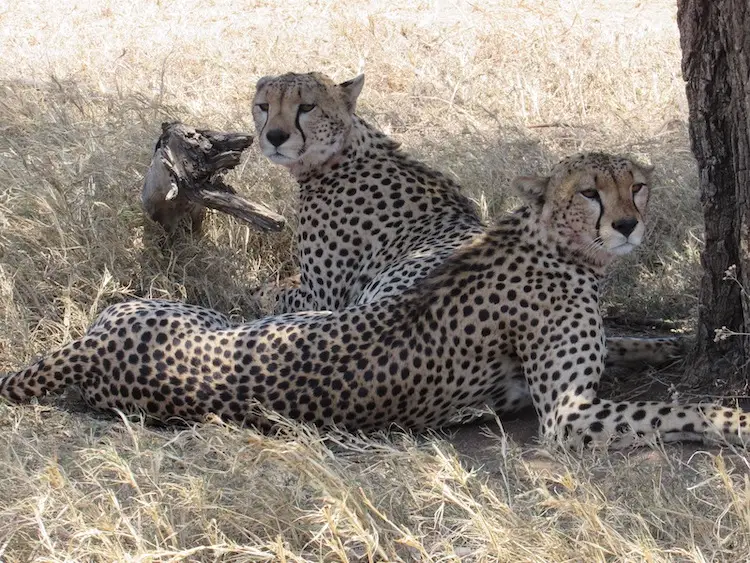
Around this time the procession approaches the Seronera area of the Serengeti National Park. This is where the tourist information center for the Serengeti NP is located. With campsites, a coffee shop, and a picnic area, this is a favorite place for visitors to sit and watch the masses of animals pass by.
After spending three days camping in Seronera, I can say that it’s crowded and noisy during this time of year, but very worth it to see these enormous herds milling around. There’s nothing like falling asleep with the sounds of thousands of animals in the neighborhood!
A word of caution – you may be tempted to bring a drone on your safari to get a bird’s-eye-view of the action. Do your homework first. One member of my group brought one into Tanzania with him and ran into a lot of rules and red tape. I suggest sticking to your good old hand-held camera.
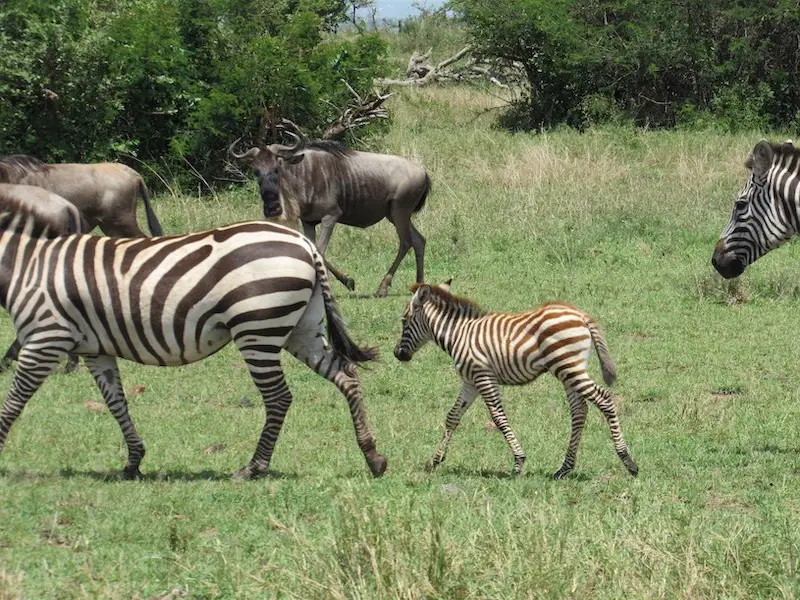
June through July
The largest herds of migrating animals will be found during these months, milling around the Grumeti River in northern Tanzania. The majority of them will have reached this point, hesitating before making their way across the river.
The Great Migration in Tanzania is quite a spectacle. There are millions of wildebeest and thousands of zebras and gazelles. Including Tanzania on your Great Migration Itinerary will NOT be a disappointment.
The river crossings are the events during the migration that hold the most drama. Predators watch for stragglers as the first animals choose the right time to brave the strong currents. They also have to avoid the Nile crocodiles waiting with open mouths for a meal.
The drama includes many predator vs predator battles as well. Lions, especially, are very territorial, and competition is fierce among the lions, and between lions and other predators.
I found it impossible to watch without my heart in my throat and my muscles tense. On the edge of my seat, literally.
The animals have about a 65 km walk to get to the second river crossing, the even more extreme Mara River. A much larger river than the Grumeti, the herds’ challenges are multiplied.
Stronger currents, a larger crocodile population, and groups of territorial hippos make for a chaotic and heart-stopping event, even for spectators.
The lucky beasts that make it to the other side still have to face waiting predators, eager to take down the tired and panicky animals. Those that survive can feast on the thick, lush green grass of the Maasai Mara Game Reserve.
Still others will remain in Tanzania, not making the river crossing at all.
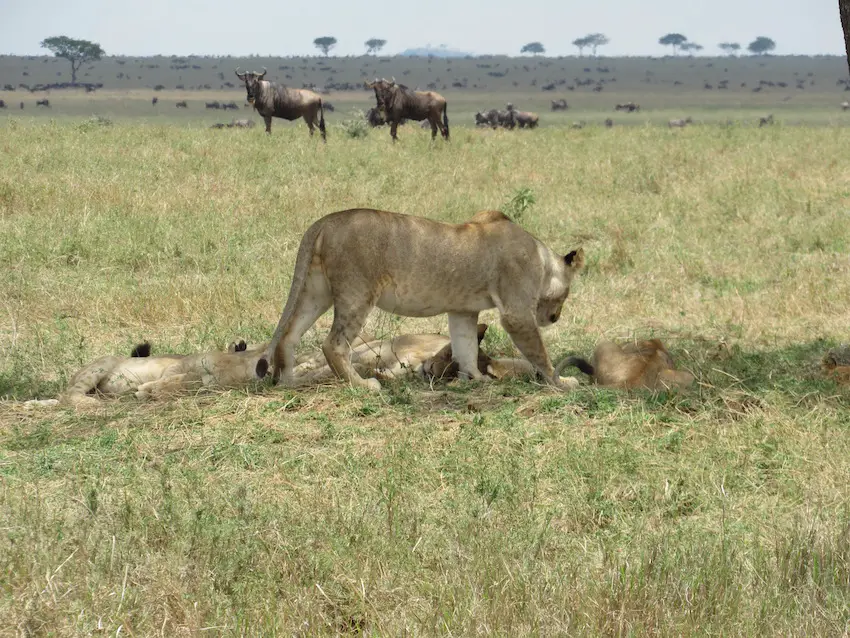
The herds begin their crossings roughly towards the end of July, and they can go on and on for days. The herds may cross in a continuous stream or may cross in stages, with weeks between groups.
My group and I stayed in this area for 3 days, hoping to see a herd cross the river. We were forced to move on with the group of animals still grazing by the side of the river. Unfortunately, seeing a river crossing is more of a bonus than a given when it comes to watching the great migration, whether you’re in Tanzania or in Kenya.
July is also mating season among the wildebeest, known as the rut. Males will compete for females, and are known for their aggression at this time, and for the enormous racket they make. This can make for some interesting drama.
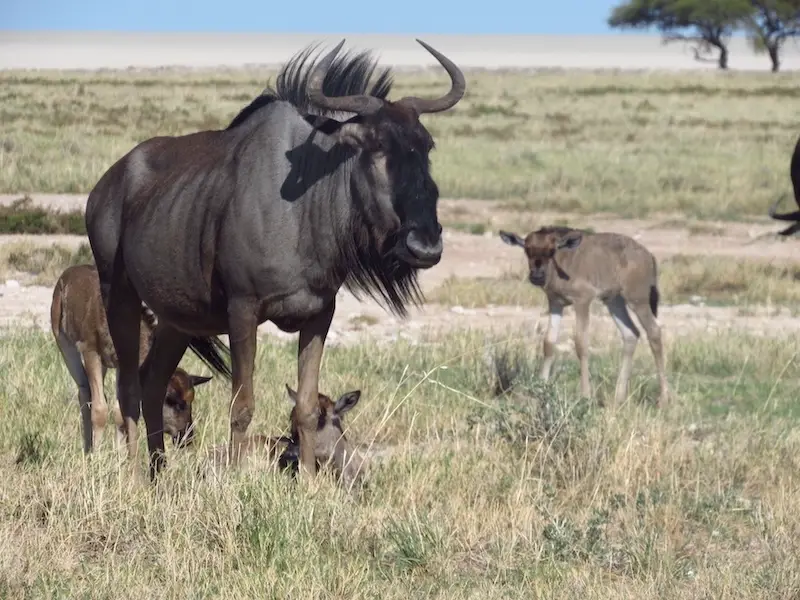
August through October
The majority of the migrating animals who make it to the Kenya side of the Mara River will spend time spread out across the Maasai Mara. They’ll get to enjoy the plentiful grass and water that it has to offer. Predators still linger, always hopeful, and interrupt the continuous grazing.
Once August and September pass and the end of October approaches, once again the water becomes hard to find and the grass becomes sparse and of poor quality. The rains will begin again in the south, and the mass migration will begin again, heading back to the southern Serengeti and Ngorongoro areas.
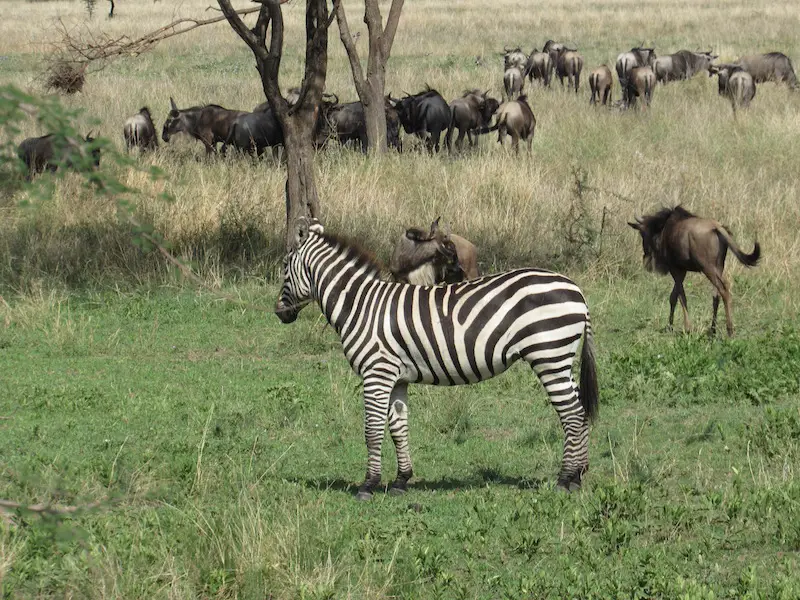
The Best Time & Place to See the Great Migration in Africa
It’s difficult to pinpoint a month or season that would be an ideal time to witness the great migration in Africa. This is due, of course, to the unpredictability of the rains, and of the animals themselves.
But in general terms, if you dream about seeing the drama and excitement of the river crossings, then your best chance would be to plan a trip toward the end of July, in August, or early September.
A longer stay in the area will give you your best chance for the sighting you’ve been dreaming of. It’s never guaranteed, though!
Or, if you’d love to see thousands of wildebeest calves finding their land legs, then February in southern Serengeti would be the best time for you.
Keep in mind that the mass migration is a year-round event. Even apart from the mind-blowing herds of animals that make up the main migration, there are always many animals to see. Even if you happen to miss the main event, you’ll never go home disappointed.
If you are planning a solo trip to view this spectacular event, there are many tips for solo travelers that can help make this a memorable vacation of a lifetime.
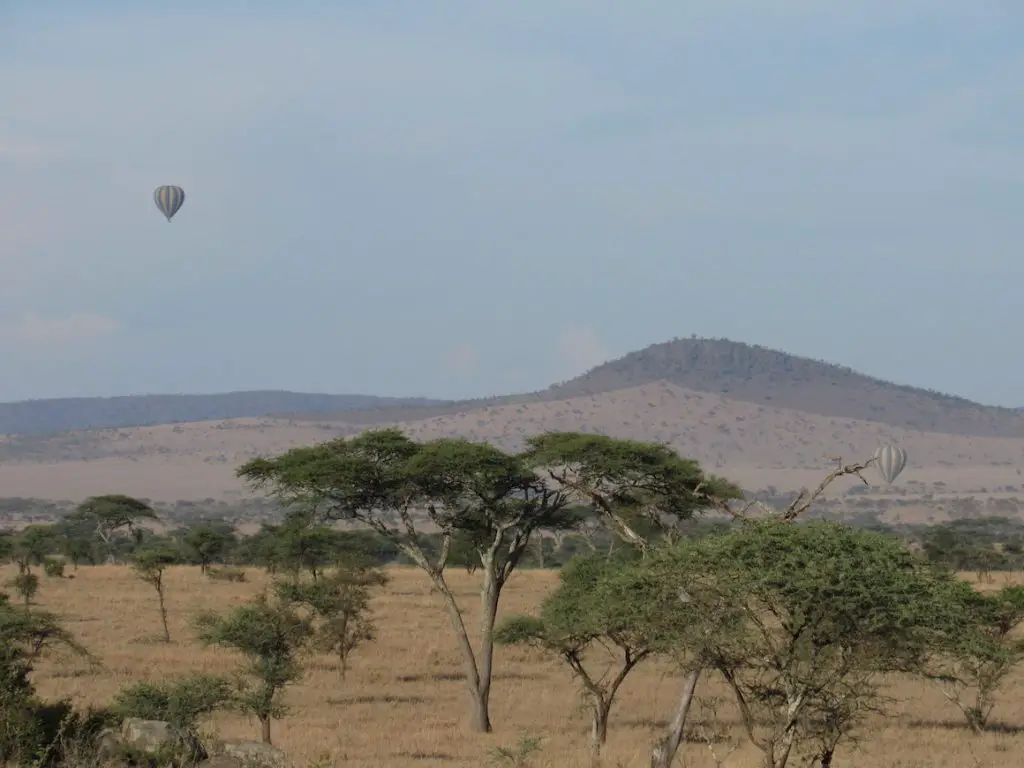
More Amazing Migration Facts
- Contrary to popular belief, the great migration isn’t made up of one single herd of moving animals. Though it may appear this way to an observer, the parade of animals is made up of many, many herds.
- A great way to witness the migration from above is with a hot air balloon ride. These are available at the Seronera area of the Serengeti National Park, and provide the view of a lifetime.
- Not all the wildebeest along the migration route will migrate. Some animals decide to stay put and make due with the available food until the rains return. If pickings get slim enough, wildebeest will eat leaves from shrubs and trees.
- The Great Migration around Tanzania and Kenya is not the only “great” migration in Africa. Boma National Park in South Sudan is host to a newly discovered antelope migration. This event involves an estimated 1.3 million antelope of different species.
Final words about the Great Migration in Africa
The Great Migration is an exciting, awe-inspiring event that is full of drama and unpredictability. Each year millions of wildebeest make their way through East Africa’s Serengeti-Mara Ecosystem on an epic journey in search of fresh grazing land. And if we’re lucky, we get to witness it.
This incredible natural phenomenon is a prime example of the beauty and majesty of nature and is a must-see for any traveler. Seeing even a small part of the Great Migration is an unforgettable experience that will stay with you forever. Don’t leave this bucket list item unchecked!
Like this post? PIN IT for later!
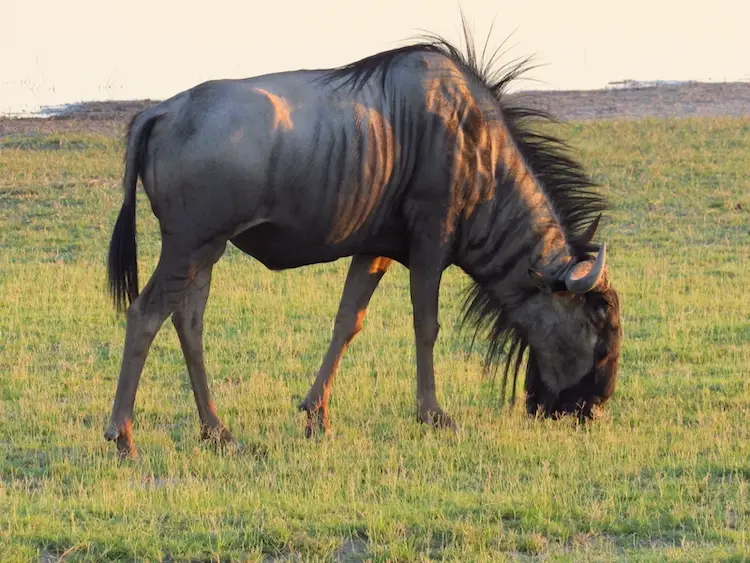
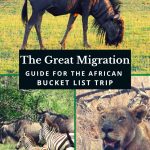


I’ve seen the June/July migration a few times and it never ceases to amaze me!
This post is so helpful! I’ve been to Africa a few times and am always amazed about how the time of the year drastically changes what you see. Thanks for all the details!